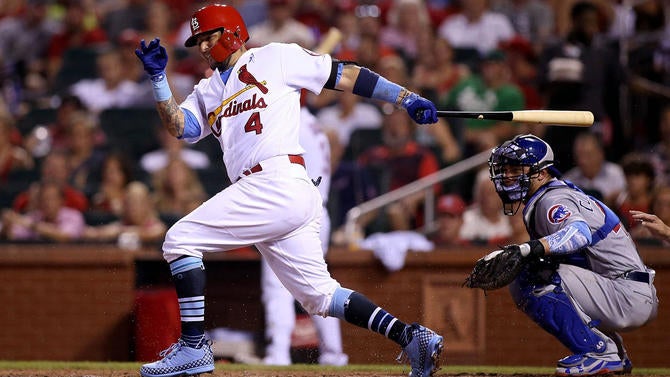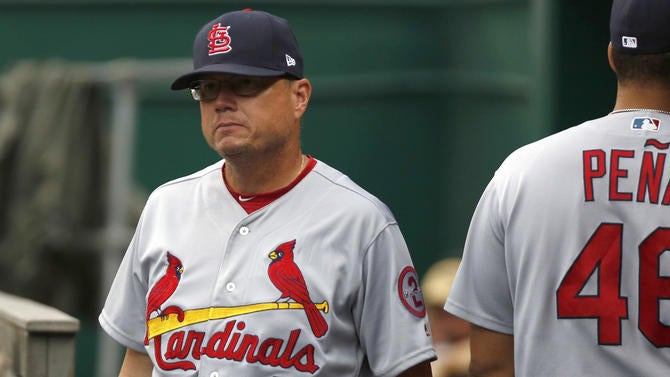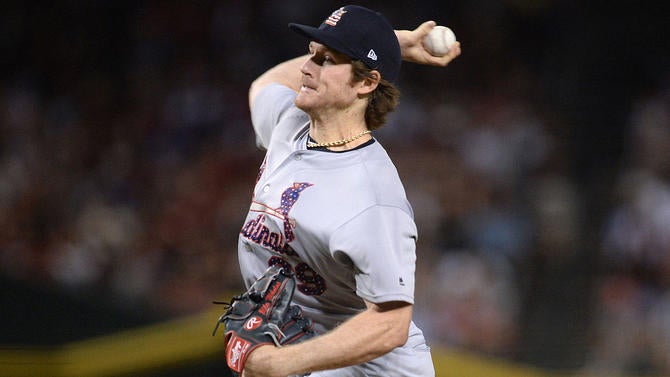Cardinals are back in playoff picture thanks to interim manager Mike Shildt's different approach
Shildt has made a few changes since taking over right before the All-Star break
The Cardinals continued their march toward the postseason on Monday night, defeating the Washington Nationals in dramatic fashion for their sixth consecutive win. Now two games back in the wild-card race, the Cardinals have gone 17-9 since firing Mike Matheny and installing Mike Shildt as their interim manager the day before the All-Star break. According to SportsLine's projections, the Cardinals have a 32 percent shot at reaching the postseason.
Predictably, Shildt's Q Score has improved along the way, with his odds of becoming the new Brian Snitker -- that is, an interim skipper who gets the job permanently -- increasing with each win. The average observer might wonder, what exactly has Shildt done differently -- has he implemented new tactics and ideas, or has he been blessed with good timing?
The answer is, well, both. The timing part doesn't need much explanation so let's break down a few areas where Shildt has departed from the Matheny norm.
Batting order

Shildt has mostly stayed true to what Matheny did when building his lineup. The big difference is he's embraced batting catcher Yadier Molina second -- something Matheny resisted. Molina has batted second in 25 of Shildt's 26 games thus far, notable because he'd hit second just 24 times in his career prior to Shildt taking over. Yes, Molina has already hit second more for Shildt in a month than he had for Tony La Russa and Matheny in 14-plus years combined. Wild.
Presumably Matheny didn't want the slow Molina batting ahead of the middle of the order. Shildt might be an iconoclast, but the decision makes sense. Molina has been one of the Cardinals most productive hitters, and batting him ahead of the likes of Jose Martinez, Marcell Ozuna, and Paul DeJong helps to leverage that trio's power in a way that isn't true when the order is flipped.
You might point out that Matheny's usual No. 2 hitter, Tommy Pham, was traded at the deadline, leaving Shildt no option but to plug in someone different. Yet we're giving Shildt credit here because he made the switch two weeks before Pham was dealt. The combination of the Pham deal and Dexter Fowler's injury has allowed Shildt to slot Martinez in as the No. 3 hitter. That means the Cardinals are batting their three most productive hitters (by OPS+) 1-3-2.
Hitting philosophy

There's a beat-or-hook aspect to analyzing how teams change from one manager to another. For example, the Cardinals have embraced younger players since Matheny was exiled -- is that because what they were doing wasn't working, or because they felt Matheny wasn't capable of handling those players and their development correctly? We don't know the answer.
By the same token, we don't know how much some of the philosophical differences between Matheny and Shildt are driven by the circumstances at hand. Still, it's clear that the Cardinals have changed how they approach their offense, beginning with a pregame hitters' meeting that was installed by Shildt after he took over. Here's more, via Jenifer Langosch of MLB.com:
These daily sessions, implemented by Mike Shildt when he took over as manager, are forums in which the staff highlights little things done well -- situational hitting, two-strike approach, two-out success -- by cueing up video from the night before. They talk, too, about the approach they'll carry into the upcoming game.
That isn't the only change Shildt has made. Bernie Miklasz of The Athletic recently noted that the Cardinals have been far more likely to hit-and-run under Shildt than they were under Matheny. The Cards have also been more likely to attempt a stolen base (0.68 per game in the second half versus 0.59 in the first) as well as more likely to succeed (76 percent versus 60 percent); and they've half as likely to bunt. Add it all up, and the Cardinals are also more likely to score.
Pitching staff

You might suspect that Shildt has installed a bold strategy with his staff -- like removing his starters earlier in games. That's true, but only by a batter per game as compared to Matheny. The Cardinals haven't taken to shifting a ton more since Shildt grabbed the reins, either -- and their results on shifts have worsened, per data provided by Baseball Info Solutions.
Rather, the biggest tweak on the pitching staff has been personnel-based. The Cardinals remade their bullpen heading into August, shipping out Greg Holland, Tyler Lyons, and Sam Tuivailala and adding Dakota Hudson, Chasen Shreve, and Tyler Webb. Combined with injuries to a number of vets it's hard to make a real one-to-one comparison between their usage.
It is worth noting, however, that Shildt is almost certainly a better bullpen strategist than Matheny by default. Past studies have shown Matheny was the worst bullpen manager in baseball, to the extent that he was deemed worse than a random number generator -- that isn't a joke. Shildt doesn't have to be good at running a 'pen to be a massive upgrade.
The same sentiment applies to other aspects of managing, too. For instance, it doesn't matter if Shildt isn't as good as Dusty Baker at calming a clubhouse … he'll appear to have balm-like qualities just so long as he's better than Matheny. In a sense, then, Shildt has benefited from good timing in multiple regards. He inherited a team that seemed to have more talent than it had shown; a front office who was ready to rid themselves of underperformers; and a post that had previously been occupied by one of baseball's most criticized skippers.
Almost anything Shildt did would have looked good by comparison -- and so far, that's been exactly the case.


















